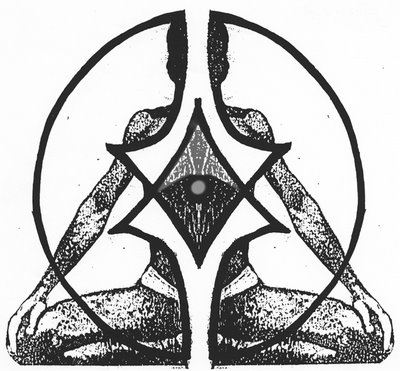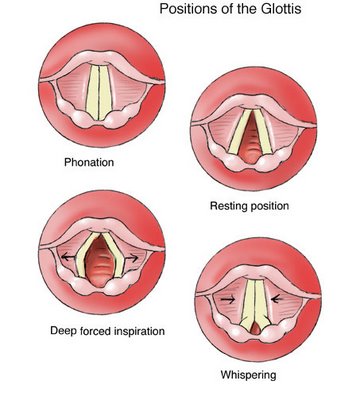Hi All.
Well, it was entirely predictable that I'd be late with this e-mail this week - due to all the activity surrounding our Thursday benefit and weekend open house.
This week, your task is easy. Please read the attached piece of writing, think about it, and come to class prepared to discuss its relevance to our studies.
After doing that, we will have a unique opportunity to view the latest footage from
Gil Hedley's Integral Anatomy Series on the cranial and visceral fascia - which includes the diaphragm and lungs. This volume has not yet been released to the public, so thanks to Gil's generosity in sharing it with me, we will be some of the first people to view it. I'm very excited about sharing this with you - almost as excited as Gil was when he handed it to me at the benefit on Thursday.
See you Wednesday.
Leslie
Please read - and meditate on its significance...
A Tale of Two Farmers - A Parable(based on the Yogasutra of Patañjali, Chapter 4, Sutra 3)
"Change in the characteristics of matter or mind can be achieved through profound intelligence (Prakriti-Apurat - lit: "by the inflow of nature")...
...but such intelligence can only remove obstacles that obstruct certain changes. Its role is no more than that of a farmer who cuts a dam to allow water to flow into the field where it is needed."
Once upon a time, there was a farmer. He owned fine fields that had good soil and water nearby. When planting time came, he put his seeds into the ground in long, straight rows. Since the seeds needed water, the farmer’s next job was getting the water to his fields. He used the same tools for this task that his father, his father’s father, and all his ancestors had used before him.
His watering tools were two large buckets with rope handles, and a wooden carrying stick that fit across the back of his shoulders. With his stick and buckets, he went up the hill near his fields to a pond that was there. At the pond, he filled the buckets with water and slipped the ends of the carrying stick under the rope handles. Balancing the stick on his shoulders, he then carried the water-filled buckets down the hill to his fields, where he emptied them into the furrows where his seeds were planted.
In order to water his crops fully, the farmer had to repeat this process hundreds of times. It was hard, backbreaking work, but the crops grew. In time, the farmer’s family grew also, and he had to plant even more crops in order to feed them. As soon as his children were old enough, they were given buckets and sticks of their own so they could help their father in growing their food.
In this manner, the farmer and his family managed to survive on the food they grew in their fields. It was a difficult life, filled with hard labor that left them hungry and tired at the end of the day. They did enjoy a respite from their labors in the cold season, when they ate the food they had stored up, mended their buckets and carved improved versions of their carrying sticks.

Miles away from the first farmer and his family lived another farmer who owned fine fields that had good soil and water nearby. When planting time came, the second farmer also put his seeds into the ground in long, straight rows. But when it came time to water his fields, the second farmer used a different tool than the first farmer.
The tool that the second farmer used to water his fields was a shovel.
With his shovel, the second farmer dug a set of channels alongside the rows of seeds he had planted. He made sure that these channels all connected with each other, and then joined them to a wider channel that he began digging up the hill that was next to his fields. It was hard, backbreaking work that took him days to complete, but when the farmer finally reached the pond at the top of the hill, he paused to rest and view the result of his efforts. Then, picking up his shovel once more, he delivered a final, precise blow to the last bit of earth that separated his channel from the pond.
The farmer watched with satisfaction as the water gushed into the gap and flowed through the wide channel that ran down the side of the hill. From there, the water flowed freely into the network of smaller channels that fed the furrows where his seeds were planted.
When his fields had been sufficiently watered, the farmer used a lever to lower a large stone into the channel where it connected to the pond. In this manner, he was able to precisely control the flow of water to his crops.
Armed with his shovel, some leverage, and his knowledge of water’s tendency to seek its own level, the second farmer not only survived, but prospered. His family grew, as did his farm. In fact, he produced more food than his family needed, and was able to share his surplus with his neighbors. All year round, his well-fed family enjoyed many creative activities, including weaving, sewing, and producing beautifully crafted shovels—which they generously taught their neighbors how to use.
Eventually, one of those shovels found its way to the first farmer—who, after learning how to use it (and making the proper apologies to his ancestors), happily abandoned the use of his buckets.
© Leslie Kaminoff
 Recently, I was contacted by a group of Korean yogis who wanted myhelp in getting their book and videos released in the USA. Apparently, their "Cosmic Revivification Yoga" is widely practiced and medically endorsed in South Korea. As a way of helping them get the word out, I've invited them to present a FREE open class at The Breathing Project. Please let as many people as you can know about this. I'd like to fill the room for them.
Recently, I was contacted by a group of Korean yogis who wanted myhelp in getting their book and videos released in the USA. Apparently, their "Cosmic Revivification Yoga" is widely practiced and medically endorsed in South Korea. As a way of helping them get the word out, I've invited them to present a FREE open class at The Breathing Project. Please let as many people as you can know about this. I'd like to fill the room for them.




































